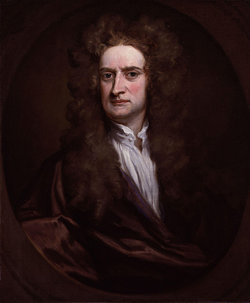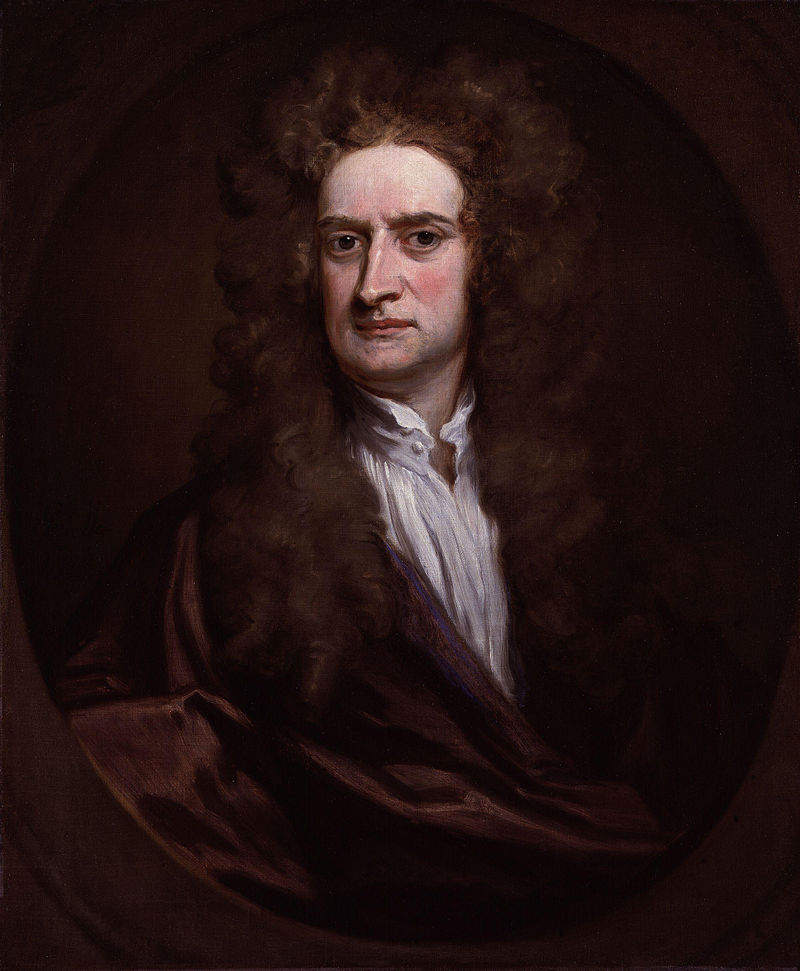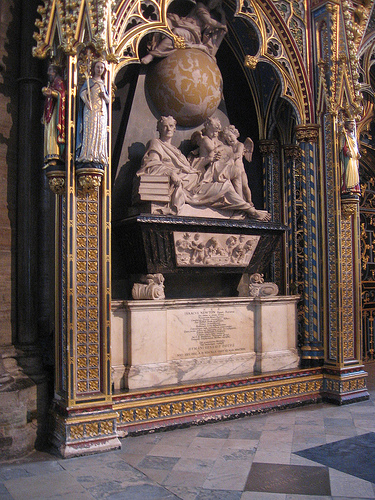Scientist. An English scientist, astronomer, physicist and mathematician, he is considered one of the greatest names in the history of human thought. Buried in Westminster Abbey, his memorial statue in the chapel of Trinity College, Cambridge, England, of which he was a distinguished member, is inscribed "Qui genus humanum ingenio superavit" (He surpassed the race of man in understanding). Born in Woolsthorpe-by-Colsterworth, Lincolnshire, England, he attended Grantham grammar school. As a boy, he was more interested in making mechanical devices than in studying, and was a poor student. His youthful inventions included a small working windmill, a clock that operated by the force of dropping water, and a sundial. His father died 2 1/2 months before he was born. Isaac left school to help his mother manage the family farm. In 1661, he entered Trinity College, part of Cambridge University, but he showed no exceptional ability during his tenure as a student, and graduated in 1665. He returned to Cambridge in 1667 to teach, and became a professor of mathematics in 1669. He was elected a fellow of the Royal Society in 1672. He studied gravity and motion in 1665 and 1666, claiming that he discovered the force of gravity while drinking tea in his garden and observing an apple fall from its tree. He suddenly realized that the force that pulled the apple to earth is the same force that keeps the moon and the planets in orbit. This force, which he called gravitational attraction, depends upon the amount of matter in the bodies being attracted to each other and the distance between the bodies. For twenty years, nothing was done with his theories other than occasional further study, until 1684, when English astronomer Edmond Halley came to him asking for help to explain the motion of planets around the sun. Halley quickly discovered that Newton had already worked out the forces and the mathematics of the planet's motion, and Halley put aside his own work to publish Newton's discoveries. Newton's discoveries on the laws of motion and theories of gravitation were published in 1687 in the book "Philosophiae Naturalis Principia Mathematica" (Mathematical Principles of Natural Philosophy), now just called "Principia." This book has been considered one of the greatest single contributions in the history of science. His discoveries in optics were equally great: in 1704, he published his discoveries in "Opticks," explaining why objects appear to be colored, and laid out the foundation of spectrum analysis. He would go on to invent the reflecting telescope, and became the first person to see Jupiter's moons. He would also invent calculus, to explain motion in mathematical terms. A lifelong bachelor, in 1701 he left Trinity College to settle in London, where he devoted his time to Parliament and to the Royal Society. From 1703 to his death in 1727, he served as President of the Royal Society, and in 1705, Queen Anne knighted him. The stereotypical absent-minded professor, Newton was considered very generous to the other scientists and publishers who helped him with his work. Albert Einstein, the great German-American physicist, stated that without Newton, his work would have been impossible, and that Newton's concepts "are even today still guiding our thinking in physics." Newton died in 1727 at the age of 84, and was buried in Westminster Abbey; burial there is considered one of the highest honors in Great Britain that can be bestowed upon a person.
Scientist. An English scientist, astronomer, physicist and mathematician, he is considered one of the greatest names in the history of human thought. Buried in Westminster Abbey, his memorial statue in the chapel of Trinity College, Cambridge, England, of which he was a distinguished member, is inscribed "Qui genus humanum ingenio superavit" (He surpassed the race of man in understanding). Born in Woolsthorpe-by-Colsterworth, Lincolnshire, England, he attended Grantham grammar school. As a boy, he was more interested in making mechanical devices than in studying, and was a poor student. His youthful inventions included a small working windmill, a clock that operated by the force of dropping water, and a sundial. His father died 2 1/2 months before he was born. Isaac left school to help his mother manage the family farm. In 1661, he entered Trinity College, part of Cambridge University, but he showed no exceptional ability during his tenure as a student, and graduated in 1665. He returned to Cambridge in 1667 to teach, and became a professor of mathematics in 1669. He was elected a fellow of the Royal Society in 1672. He studied gravity and motion in 1665 and 1666, claiming that he discovered the force of gravity while drinking tea in his garden and observing an apple fall from its tree. He suddenly realized that the force that pulled the apple to earth is the same force that keeps the moon and the planets in orbit. This force, which he called gravitational attraction, depends upon the amount of matter in the bodies being attracted to each other and the distance between the bodies. For twenty years, nothing was done with his theories other than occasional further study, until 1684, when English astronomer Edmond Halley came to him asking for help to explain the motion of planets around the sun. Halley quickly discovered that Newton had already worked out the forces and the mathematics of the planet's motion, and Halley put aside his own work to publish Newton's discoveries. Newton's discoveries on the laws of motion and theories of gravitation were published in 1687 in the book "Philosophiae Naturalis Principia Mathematica" (Mathematical Principles of Natural Philosophy), now just called "Principia." This book has been considered one of the greatest single contributions in the history of science. His discoveries in optics were equally great: in 1704, he published his discoveries in "Opticks," explaining why objects appear to be colored, and laid out the foundation of spectrum analysis. He would go on to invent the reflecting telescope, and became the first person to see Jupiter's moons. He would also invent calculus, to explain motion in mathematical terms. A lifelong bachelor, in 1701 he left Trinity College to settle in London, where he devoted his time to Parliament and to the Royal Society. From 1703 to his death in 1727, he served as President of the Royal Society, and in 1705, Queen Anne knighted him. The stereotypical absent-minded professor, Newton was considered very generous to the other scientists and publishers who helped him with his work. Albert Einstein, the great German-American physicist, stated that without Newton, his work would have been impossible, and that Newton's concepts "are even today still guiding our thinking in physics." Newton died in 1727 at the age of 84, and was buried in Westminster Abbey; burial there is considered one of the highest honors in Great Britain that can be bestowed upon a person.
Bio by: Kit and Morgan Benson
Advertisement
See more Newton memorials in:
Records on Ancestry
Sponsored by Ancestry
Advertisement



